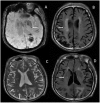Association of Renal Dysfunction With Remote Diffusion-Weighted Imaging Lesions and Total Burden of Cerebral Small Vessel Disease in Patients With Primary Intracerebral Hemorrhage
- PMID: 29930507
- PMCID: PMC6001158
- DOI: 10.3389/fnagi.2018.00171
Association of Renal Dysfunction With Remote Diffusion-Weighted Imaging Lesions and Total Burden of Cerebral Small Vessel Disease in Patients With Primary Intracerebral Hemorrhage
Abstract
Objective: Remote diffusion-weighted imaging (DWI) lesions (R-DWIL) found in intracerebral hemorrhage (ICH) patients are considered as an additional marker of cerebral small vessel disease (cSVD). This study aimed to investigate the association of renal dysfunction and R-DWIL, as well as the total burden of cSVD on magnetic resonance imaging among patients with primary ICH. Methods: One hundred and twenty-six consecutive patients were prospectively enrolled. R-DWIL on DWI, as well as other imaging markers of cSVD, including lacunes, white matter lesions, cerebral microbleeds, and enlarged perivascular spaces were rated using validated scales. Renal dysfunction was evaluated either by reduced estimated glomerular filtration rate (eGFR) or the presence of proteinuria or increased cystatin C. Results: After adjustments for potential confounders by logistic regression, impaired eGFR [odds ratio (OR) 6.00, 95% confidence interval (CI) 1.73-20.78], proteinuria (OR 3.07, 95% CI 1.25-7.54) and increased cystatin C (OR 2.73, 95% CI 1.11-6.72) were correlated with presence of R-DWIL. A similar association was also found between cystatin C levels (OR 3.16, 95% CI 1.39-7.19), proteinuria (OR 2.79, 95% CI 1.34-5.83) and the comprehensive cSVD burden. Conclusions: Renal dysfunction are associated with the presence of R-DWIL, and total burden of cSVD in patients with primary ICH.
Keywords: cerebral small vessel disease; cystatin C; glomerular filtration rate; proteinuria; remote DWI lesions; renal dysfunction.
Figures



Similar articles
-
Association between remote diffusion-weighted imaging lesions and cerebral small vessel disease in primary intracerebral hemorrhage.Eur J Neurol. 2019 Jul;26(7):961-968. doi: 10.1111/ene.13915. Epub 2019 Mar 5. Eur J Neurol. 2019. PMID: 30742740
-
Chronic Kidney Disease in Patients With Lacunar Stroke: Association With Enlarged Perivascular Spaces and Total Magnetic Resonance Imaging Burden of Cerebral Small Vessel Disease.Stroke. 2015 Aug;46(8):2081-6. doi: 10.1161/STROKEAHA.114.008155. Epub 2015 Jul 2. Stroke. 2015. PMID: 26138123
-
Association Between Serum Cystatin C Level and Total Magnetic Resonance Imaging Burden of Cerebral Small Vessel Disease in Patients With Acute Lacunar Stroke.J Stroke Cerebrovasc Dis. 2017 Jan;26(1):186-191. doi: 10.1016/j.jstrokecerebrovasdis.2016.09.007. Epub 2016 Oct 7. J Stroke Cerebrovasc Dis. 2017. PMID: 27727072
-
Association between Kidney Function and the Burden of Cerebral Small Vessel Disease: An Updated Meta-Analysis and Systematic Review.Cerebrovasc Dis. 2023;52(4):376-386. doi: 10.1159/000527069. Epub 2023 Jan 4. Cerebrovasc Dis. 2023. PMID: 36599326
-
Effects of cerebral small vessel disease on the outcome of patients with ischemic stroke caused by large artery atherosclerosis.Neurol Res. 2018 May;40(5):381-390. doi: 10.1080/01616412.2018.1446283. Epub 2018 Mar 15. Neurol Res. 2018. PMID: 29543130 Review.
Cited by
-
A Simple Review of Small Vessel Disease Manifestation in the Brain, Retina, and Kidneys.J Clin Med. 2022 Sep 22;11(19):5546. doi: 10.3390/jcm11195546. J Clin Med. 2022. PMID: 36233417 Free PMC article. Review.
-
Changes in Cerebral Blood Flow and Diffusion-Weighted Imaging Lesions After Intracerebral Hemorrhage.Transl Stroke Res. 2022 Oct;13(5):686-706. doi: 10.1007/s12975-022-00998-6. Epub 2022 Mar 19. Transl Stroke Res. 2022. PMID: 35305264 Review.
-
Asymmetry of Lacunae between Brain Hemispheres Is Associated with Atherosclerotic Occlusions of Middle Cerebral Artery.Brain Sci. 2023 Jun 30;13(7):1016. doi: 10.3390/brainsci13071016. Brain Sci. 2023. PMID: 37508948 Free PMC article.
-
Stress-Induced Hyperglycemia and Remote Diffusion-Weighted Imaging Lesions in Primary Intracerebral Hemorrhage.Neurocrit Care. 2020 Apr;32(2):427-436. doi: 10.1007/s12028-019-00747-y. Neurocrit Care. 2020. PMID: 31313140
-
Association Between White Matter Hyperintensities and Chronic Kidney Disease: A Systematic Review and Meta-Analysis.Front Med (Lausanne). 2022 May 3;9:770184. doi: 10.3389/fmed.2022.770184. eCollection 2022. Front Med (Lausanne). 2022. PMID: 35592851 Free PMC article.
References
-
- Banerjee G., Wahab K. W., Gregoire S. M., Jichi F., Charidimou A., Jäger H. R., et al. . (2016). Impaired renal function is related to deep and mixed, but not strictly lobar cerebral microbleeds in patients with ischaemic stroke and TIA. J. Neurol. 263, 760–764. 10.1007/s00415-016-8040-4 - DOI - PubMed
LinkOut - more resources
Full Text Sources
Other Literature Sources
Research Materials
Miscellaneous

